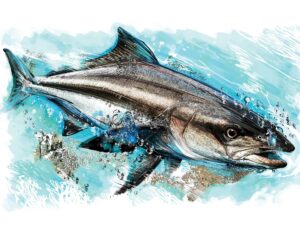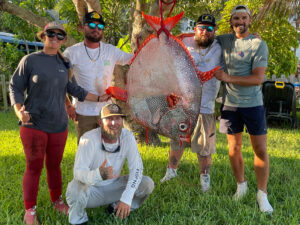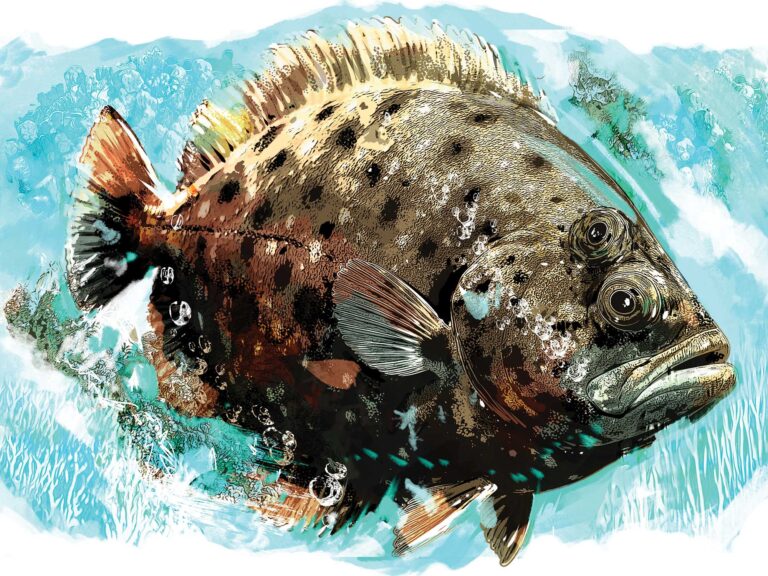
Few other fish possess the mystique of the white seabass, especially in the minds of Southern California saltwater anglers. The bright silvery croakers rank as one of the most coveted of all ocean gamefish on the West Coast. They can reach weights in excess of 60 pounds, and catching just one in a day of fishing triggers breathless celebration among a team of anglers.
The chances of catching one white seabass (the daily bag limit per angler from March 15 to June 15) or as many as three (the daily limit during other times) increases in spring and early summer as these fish follow the biomass of opalescent squid that, in most years, visit the waters of SoCal’s offshore islands such as Santa Barbara, Santa Catalina, San Clemente, Santa Cruz and Santa Rosa. Known as “candy bait,” squid become the preferred offering for these croakers in spring. In fact, on many days, squid—live, fresh dead or thawed frozen pieces—is the only bait that will elicit a bite.

Tanking Up
With squid serving as the lynchpin of a successful outing, white seabass anglers expend extraordinary efforts to fill livewells with candy bait. It’s called “tanking up,” and in years past, it often involved spending the night bobbing around on the squid-spawning grounds around one of the offshore islands.
Opalescent squid tend to spawn over sandy bottoms in about 120 feet of water, but they often rise to a light source. So boating anglers hang bright lights above and below the water to attract squid. Sometimes they form a floating school, allowing anglers to dip-net or use a crowder—a wide, flat fine-mesh net with a telescoping pole on each end. With a person on each pole, the crowder is lowered straight down, and then pivoted outward and lifted to the surface to corral the school before dip-netting the captives into the livewell.
In recent years, however, the growing popularity of this live bait has prompted a number of bait boats along the coast to net squid in purse seines and either sell it to anglers as they arrive at the islands or haul it back to ports along the coast so boaters can tank up before heading over the islands. A scoop consisting of two brails of live squid now sells for about $80.
Night Moves
An advantage of spending the night to catch squid lies in the opportunity to catch white seabass at the same time. The croakers sometimes cruise near the surface just outside the ring of lights used to attract squid, picking off stragglers that wander too far from the main school.
To catch these fish, anglers sometimes use floats to suspend a squid bait 6 to 12 feet below the surface. Using a Danielson EDF 1½ Easy Drifter foam float, attach a thin cord around the fishing line using a nail-knot to stop the line above the float presetting the depth of the bait. Tie on an Owner Aki Twist hook in a 7/0 to 8/0 size, and use a ¼- to 3/8-ounce egg sinker that slides down to the hook to keep the bait as vertical as possible below the float.
White seabass might also cruise below the schooling squid; astute anglers also drop white heavy metal jigs such as a 6-ounce Tady 4/0 with a single 8/0 Siwash hook with one or more live squid pinned to the hook. This replicates the spawning behavior of squid, and when dangled between the glow of the surface light and bottom, it can trick a croaker into attacking.

Gray Bite
Some of the best white seabass action occurs on the squid grounds in the morning twilight. During the time between the first inkling of light and sunrise, the croaker can feed heavily, often descending deeper to gobble up dead and dying squid off the ocean floor. This has led to a popular nickname for white seabass—gray ghosts.
To target fish in the gray, anglers drop their jig-and-squid combos deeper, and try to keep the jigs about 3 to 6 feet off the sandy bottom. This keeps the bait away from undesirable bottom feeders such as bat rays, guitarfish and leopard sharks.
A dropper-loop rig also works well in the gray. It consists of a 10-inch loop formed by a spider hitch about 4 feet above a torpedo sinker that’s tied to the bottom of the rig. Use the double line of the loop to tie on a 7/0 to 8/0 Owner Aki Twist with a Palomar knot and attach an 8- to 10-ounce sinker to bottom to keep the line as vertical as possible in the current. As with a metal jig, place the sinker well above the bottom. If fishing multiple rods, stagger the lines at different depths with the goal of putting out a spread that will intercept any white seabass swimming under the boat.

Shore Patrol
Once the sun is up, white seabass often retreat to the shadows of the thick kelp beds that rim the islands. Daytime fishing these spots can pay off, especially on days when a good current sweeps the shore areas. A prime indicator is a milky-color break extending from the edge of the kelp along a sandy beach. The croakers feed along these breaks in depths from 50 to just 10 feet or less.
Anchor up to fish a nice-looking beach. Use a 3/8-ounce leadhead with a 5/0 to 7/0 hook. You can also use a ¼- or 3/8-ounce egg sinker that slides down to a 7/0 to 8/0 Aki Twist. Pin on one or more squid, cast toward the shore, and slowly work the bait back out to deeper water.
If fishing a kelp bed, the water is often deeper (40 to 60 feet). Anchor about 50 to 75 feet from the outer edge of the weeds. Using the same rigs as you would for the beaches, cast shoreward and let the current carry your bait downstream. At the same time, try to cover the water column using metal jigs and dropper loops to fish the mid-depths and bottom.
While you fish, chop up any left-over dead squid and put out a steady chum line. While this might not attract white seabass, it does draw other smaller fish, and sometimes the big croakers become curious and move in to investigate. If you do hook a seabass, toss out some live squid for chum, as these fish often travel in groups. If you can keep them around the boat, you might enjoy multiple hookups.
Read Next: Channel Islands Fishing Bonanza

Tackle Choice
In terms of tackle, serious white seabass anglers gear up with 8-foot medium-action rods and medium-size lever-drag and star-drag conventional reels spooled with 65-pound braid and a 10- to 20-foot topshot of 40- to 60-pound fluorocarbon line. The abrasion-resistant braid and fluoro better slice through the stalks of kelp should a white seabass bully its way into the weeds.

The technique works best if you back off the drag pressure a bit, if the fish finds its way into the kelp, so that the line can saw its way through. Once the fish clears the weeds, tighten up again and don’t back off until your croaker is on the gaff.








